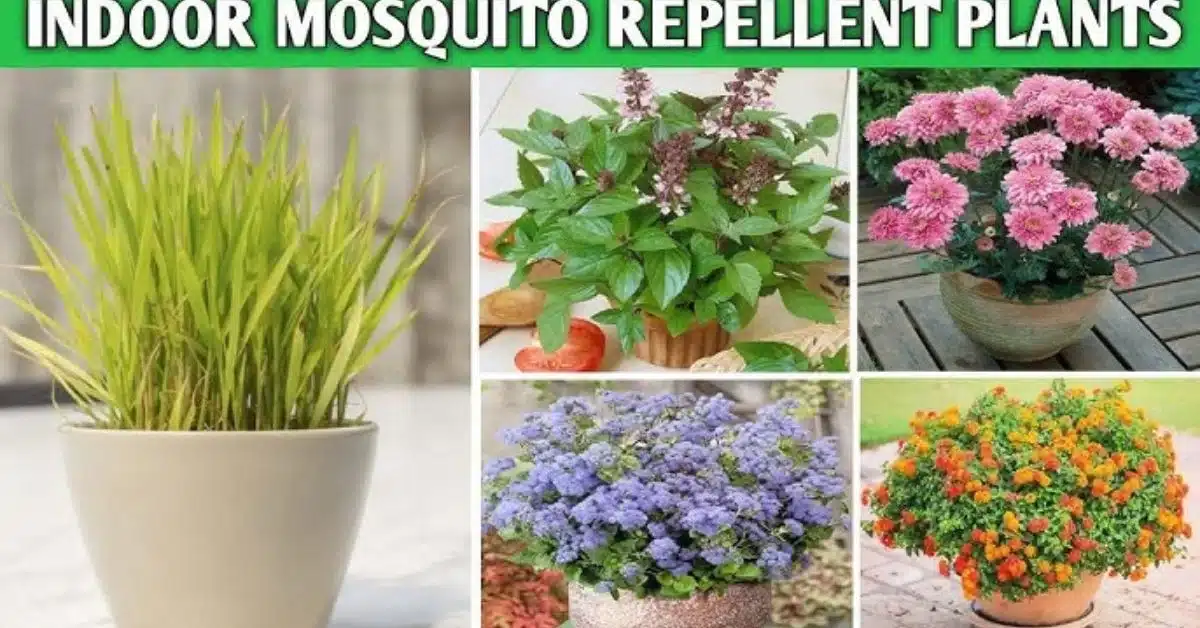Introduction
Ever wondered if you could enjoy your indoor garden without the annoyance of bugs? You’re not alone! Many indoor plant lovers face the challenge of keeping pesky insects at bay. The good news is there’s a natural solution: certain indoor plants actually repel bugs. With the right selection, you can keep your home looking beautiful, green, and pest-free—without relying on harsh chemicals.
In this article, we’ll explore 10 amazing indoor plants that naturally repel bugs. Whether you’re a seasoned indoor gardener or just getting started, these plants can help you maintain a healthier, more enjoyable indoor space. Plus, you’ll learn how to incorporate them into your home for maximum impact.
1. Lavender: The Fragrant Bug Buster
Lavender is well-loved for its soothing aroma, which not only calms the mind but also repels bugs. This plant emits a strong fragrance that many insects, like mosquitoes and moths, find unbearable. Keep lavender near windows or entry points to prevent bugs from sneaking in.
- Pro Tip: Lavender thrives in bright light, so place it by a sunny window. It’s also drought-tolerant, making it low-maintenance.
2. Peppermint: Fresh Scent, Zero Bugs
Peppermint’s refreshing aroma is perfect for repelling ants, mosquitoes, and even spiders. It’s easy to grow indoors and can double as an herb for cooking or teas.
- Real-Life Example: A friend of mine keeps a small pot of peppermint in her kitchen window. Not only does it keep flies away, but it also provides fresh leaves for her morning tea!
3. Rosemary: Culinary Herb and Natural Repellent
Rosemary is a versatile herb known for its ability to repel flies, mosquitoes, and other insects. This sturdy plant is easy to grow indoors and brings a pleasant aroma to any room.
- Usage Tip: Place rosemary near areas where food is prepared to keep bugs away. It needs plenty of sunlight, so a bright spot in your kitchen is ideal.
4. Basil: Bug-Busting Culinary Companion
Basil doesn’t just spice up your recipes; it’s also effective against flies and mosquitoes. The strong smell of basil masks the scents that insects are attracted to, making it a natural bug deterrent.
- Personal Anecdote: I keep basil near my kitchen counter, and it’s done wonders for keeping fruit flies at bay. Plus, fresh basil is always within reach when I’m cooking!
5. Catnip: The Cat’s Favorite, Bugs’ Least Favorite
Catnip might be beloved by cats, but it’s a nightmare for bugs, especially mosquitoes. Studies have shown that catnip can be even more effective than some synthetic repellents.
- Pro Tip: Grow catnip in small pots and place them around your home. If you have cats, they’ll enjoy it too!
6. Lemongrass: The Mosquito Fighter
Lemongrass contains citronella, a natural oil that repels mosquitoes. This plant grows tall and adds a beautiful touch to indoor spaces, and it can be a striking centerpiece in your vertical garden.
- Placement Idea: Lemongrass thrives in bright light. Keep it in a sunny spot, ideally near entryways where mosquitoes might enter.
7. Marigold: Bright Blooms, Fewer Bugs
Marigolds are more than just cheerful blooms—they’re natural pest repellents. They emit a scent that deters mosquitoes, aphids, and even certain harmful fungi.
- Decorative Tip: Use marigolds as part of your vertical garden to add a pop of color while keeping pests away. They’re easy to care for and bloom beautifully.
8. Mint: Freshness with Bug-Free Benefits
Like peppermint, mint is a powerful insect repellent. It’s effective against mosquitoes, ants, and flies. Plus, mint is easy to grow and works well in containers.
- Growth Tip: Mint spreads quickly, so use containers to keep it manageable. Place a pot in rooms where bugs are a problem for a fresh scent and natural repellent.
9. Chrysanthemums: Natural Insecticide
Chrysanthemums contain pyrethrin, a natural insecticide that’s used in many commercial repellents. These flowers are effective against ants, cockroaches, fleas, and ticks.
- Visual Appeal: Chrysanthemums come in various colors, so they’re great for adding vibrancy to your indoor garden while keeping pests at bay.
10. Sage: A Sturdy Herb that Bugs Avoid
Sage has a strong, earthy smell that bugs hate, especially mosquitoes and flies. It’s easy to grow indoors and can be used in cooking as well.
- Practical Use: Keep sage near areas where you relax to enjoy a bug-free environment. Sage also makes a lovely addition to any herb garden.
Setting Up Your Indoor Garden for Maximum Bug Control
Now that you know which plants repel bugs, here are a few tips to set up your space effectively:
- Use Vertical Gardening Techniques: If you’re short on space, consider vertical gardening. Stack plants in tiered planters or wall-mounted pots. This maximizes your plant variety while making the most of limited space.
- Strategic Placement: Place bug-repelling plants near windows, doors, and other entry points. This creates a natural barrier that insects are less likely to cross.
- Regular Maintenance: Keep your plants healthy and well-maintained. Trim dead leaves, water appropriately, and occasionally dust the leaves to keep them pest-free.
FAQs
Q: Which indoor plants are best for repelling mosquitoes?
A: Lavender, catnip, and lemongrass are highly effective against mosquitoes. Each of these plants has a strong scent that naturally deters mosquitoes.
Q: Can I grow these bug-repelling plants in low-light areas?
A: While some plants, like mint and catnip, can tolerate lower light, most bug-repelling plants thrive in bright, indirect sunlight. You may need to use indoor grow lights if you don’t have sufficient natural light.
Q: How can I incorporate these plants into my vertical garden?
A: Use tiered shelves, wall-mounted pots, or hanging planters for a vertical garden setup. Place bug-repelling plants at different heights to create a layered look that maximizes space and impact.
Q: Are these plants safe for pets?
A: Some of these plants, like rosemary and basil, are safe for pets, but others, like lavender and chrysanthemum, can be toxic to cats and dogs if ingested. Be sure to research each plant before adding it to your pet-friendly home.
Q: How do I care for these plants indoors?
A: Most of these plants require bright light, regular watering, and occasional trimming. Be mindful of each plant’s specific needs to keep them healthy and effective as bug repellents.
Conclusion
Creating a bug-free indoor garden doesn’t have to mean using harsh sprays or chemicals. With these 10 incredible indoor plants, you can naturally repel bugs while enjoying a lush, vibrant home. From the fragrant lavender to the culinary sage, each of these plants offers both beauty and functionality. Try incorporating them into your indoor space, and experience the difference they make!










